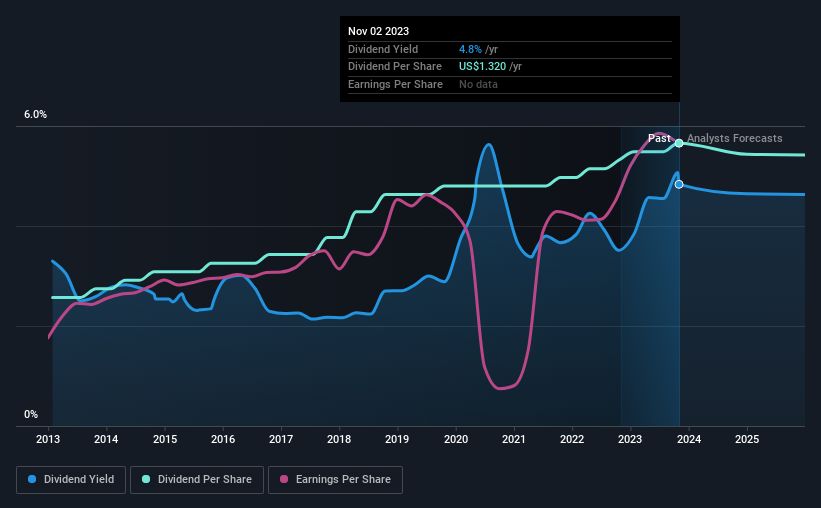There's A Lot To Like About S&T Bancorp's (NASDAQ:STBA) Upcoming US$0.33 Dividend
It looks like S&T Bancorp, Inc. (NASDAQ:STBA) is about to go ex-dividend in the next four days. The ex-dividend date is one business day before the record date, which is the cut-off date for shareholders to be present on the company's books to be eligible for a dividend payment. The ex-dividend date is important as the process of settlement involves two full business days. So if you miss that date, you would not show up on the company's books on the record date. This means that investors who purchase S&T Bancorp's shares on or after the 8th of November will not receive the dividend, which will be paid on the 24th of November.
The company's upcoming dividend is US$0.33 a share, following on from the last 12 months, when the company distributed a total of US$1.32 per share to shareholders. Based on the last year's worth of payments, S&T Bancorp has a trailing yield of 4.8% on the current stock price of $27.31. If you buy this business for its dividend, you should have an idea of whether S&T Bancorp's dividend is reliable and sustainable. So we need to investigate whether S&T Bancorp can afford its dividend, and if the dividend could grow.
View our latest analysis for S&T Bancorp
Dividends are usually paid out of company profits, so if a company pays out more than it earned then its dividend is usually at greater risk of being cut. Fortunately S&T Bancorp's payout ratio is modest, at just 34% of profit.
Companies that pay out less in dividends than they earn in profits generally have more sustainable dividends. The lower the payout ratio, the more wiggle room the business has before it could be forced to cut the dividend.
Click here to see the company's payout ratio, plus analyst estimates of its future dividends.
Have Earnings And Dividends Been Growing?
Companies with consistently growing earnings per share generally make the best dividend stocks, as they usually find it easier to grow dividends per share. If business enters a downturn and the dividend is cut, the company could see its value fall precipitously. For this reason, we're glad to see S&T Bancorp's earnings per share have risen 13% per annum over the last five years.
Another key way to measure a company's dividend prospects is by measuring its historical rate of dividend growth. S&T Bancorp has delivered 8.2% dividend growth per year on average over the past 10 years. It's encouraging to see the company lifting dividends while earnings are growing, suggesting at least some corporate interest in rewarding shareholders.
To Sum It Up
Is S&T Bancorp an attractive dividend stock, or better left on the shelf? Companies like S&T Bancorp that are growing rapidly and paying out a low fraction of earnings, are usually reinvesting heavily in their business. This strategy can add significant value to shareholders over the long term - as long as it's done without issuing too many new shares. In summary, S&T Bancorp appears to have some promise as a dividend stock, and we'd suggest taking a closer look at it.
On that note, you'll want to research what risks S&T Bancorp is facing. To help with this, we've discovered 1 warning sign for S&T Bancorp that you should be aware of before investing in their shares.
Generally, we wouldn't recommend just buying the first dividend stock you see. Here's a curated list of interesting stocks that are strong dividend payers.
Have feedback on this article? Concerned about the content? Get in touch with us directly. Alternatively, email editorial-team (at) simplywallst.com.
This article by Simply Wall St is general in nature. We provide commentary based on historical data and analyst forecasts only using an unbiased methodology and our articles are not intended to be financial advice. It does not constitute a recommendation to buy or sell any stock, and does not take account of your objectives, or your financial situation. We aim to bring you long-term focused analysis driven by fundamental data. Note that our analysis may not factor in the latest price-sensitive company announcements or qualitative material. Simply Wall St has no position in any stocks mentioned.

